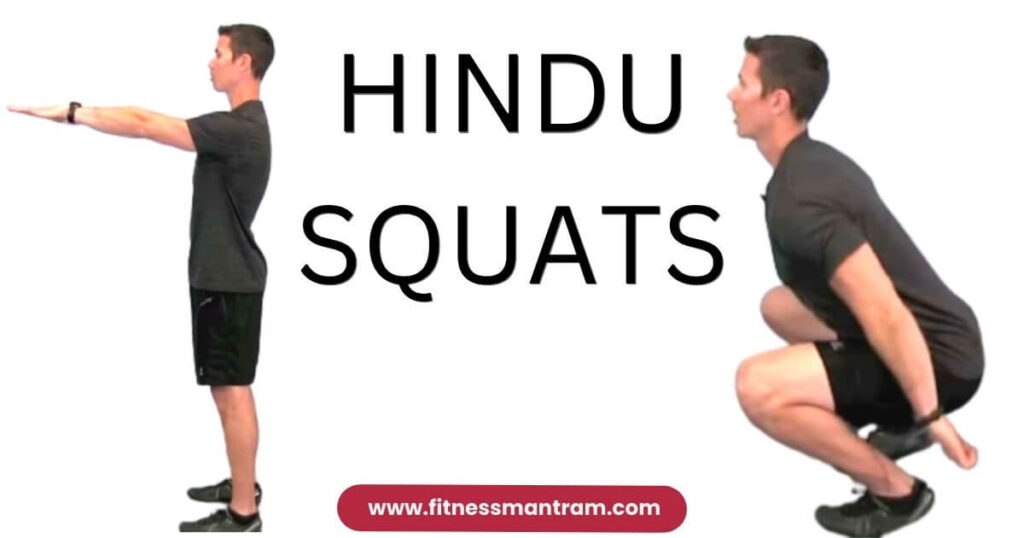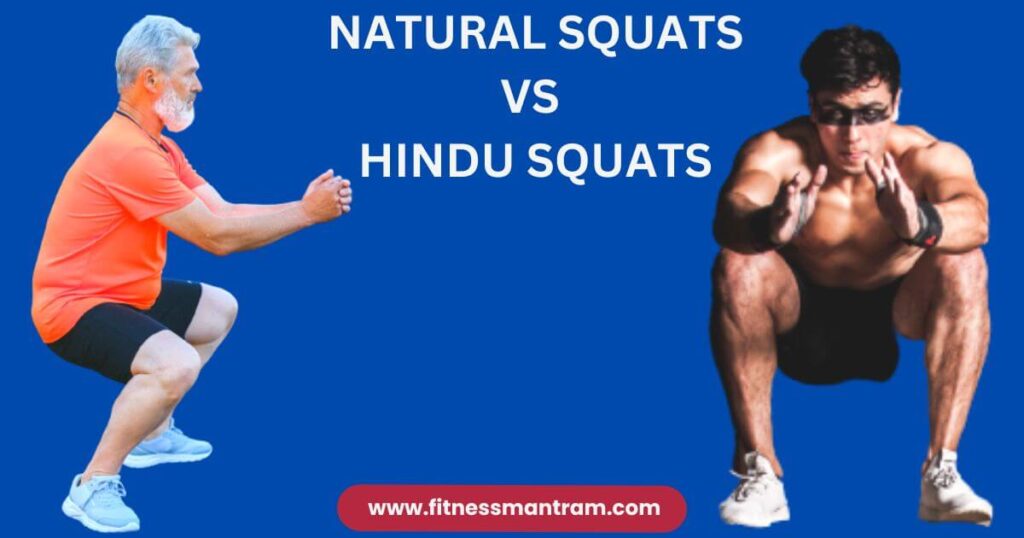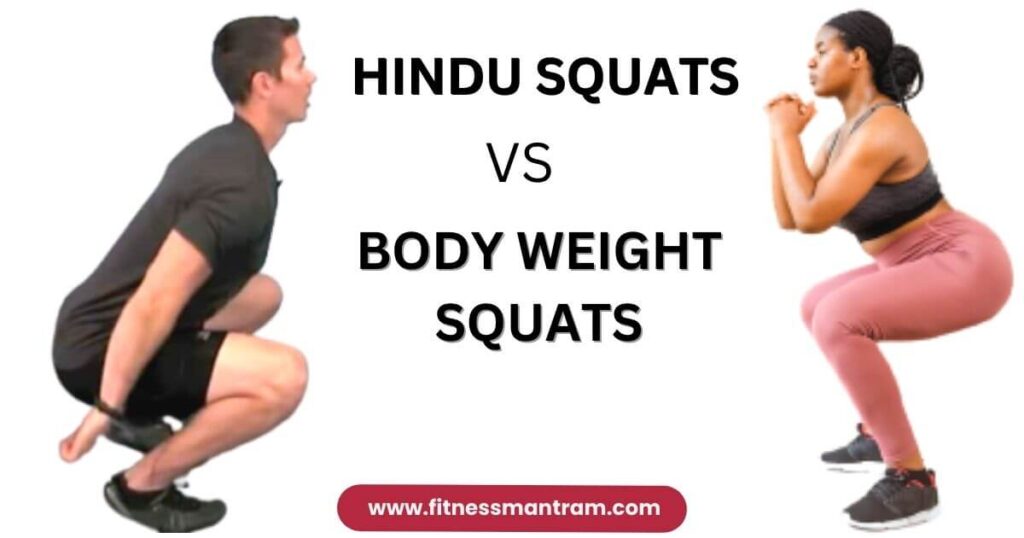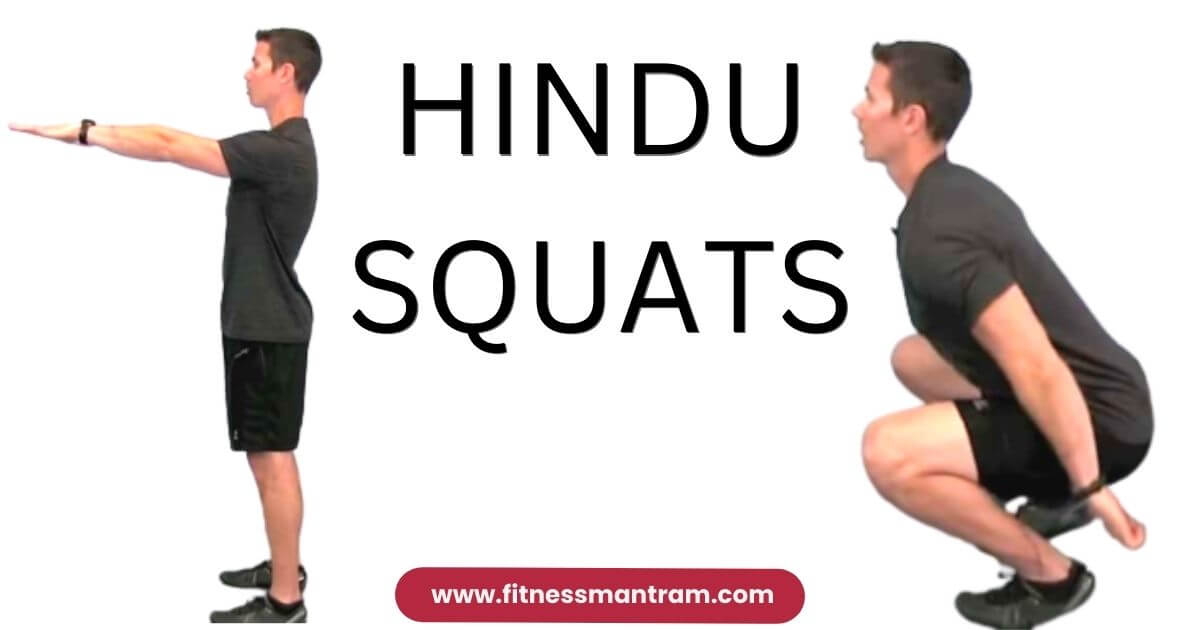Introduction.
What Is Hindu Squats?
Indian squats, also known as Hindu Squats (Baithak) are a popular fitness exercise. The Hindu Squats is a full-body exercise that primarily targets the quads, hamstrings, glutes, and calves of the lower body. Additionally, this exercise improves cardiovascular endurance and strengthens the core, including the abs and lower back. In this article, we will explore the benefits of Hindu squats, how to perform the exercise correctly, and the precautions to take while doing them.

How to Perform Hindu Squats
Although performing Hindu squats is a straightforward exercise, performing it correctly is essential to avoiding injury. Hindu squats are performed as follows:
- Start in a standing position with your arms at your sides and feet shoulder-width apart.
- By bending your knees and pushing your hips back, bring your body into a squat position.
- While lowering your body, keep your back straight and your chest up. Check to see that your knees are not collapsing inward and pointing outward.
- After a brief pause at the bottom of the squat, return to the starting position.
- You should simultaneously raise your arms above your head as you get up.
- The exercise should be repeated as many times as possible in a set.
Precautions to Take When Doing Hindu Squats
Although doing Hindu squats is a relatively safe exercise, the following precautions should be taken to prevent injury:
- Begin slowly: Start slowly and gradually increase the number of reps if you haven’t done squats in a while or are new to exercise.
- Keep your posture in check: Throughout the exercise, keep your back straight and your chest up. This will assist you in avoiding back strain.
- Avoid Squeezing Your Knees: Make sure that instead of collapsing inward, your knees are pointing outward. The knee joint will be protected from damage thanks to this.
- Wear the right footwear: Wear shoes with a non-slip sole and sufficient support. You’ll be able to keep your balance and avoid slipping thanks to this.
Benefits of Hindu Squats
Hindu squats are a great exercise for increasing fitness and strength in the lower body. Hindu squats have the following advantages:
1.Enhances Lower Body Stamina: Hindu squats are a compound exercise that work the quadriceps, hamstrings, and glutes, as well as other lower body muscles. Running, jumping, and other physical activities require these muscles.
2.Enhances Cardiovascular Durability: Hindu squats are a high-intensity exercise that can make your heart rate faster and help your body absorb more oxygen. Increasing your cardiovascular endurance over time can make it possible to engage in physical activity for longer periods.
3.Increases adaptability: Full range of motion is required for Hindu squats, which can help you become more flexible over time. Your calves, hamstrings, and hip flexors will all benefit from this exercise.
4.Reduces Fat: Hindu squats are a high-intensity exercise that can accelerate fat loss. Burning fat in the lower body is particularly effective with this exercise.
Hindu Squats vs Normal Squats
Both are popular exercises that work the quadriceps, hamstrings, and glutes in the lower body. Nevertheless, these two exercises differ in a few ways. The following are some of the differences between normal and Hindu squats:
Motion Flexibility: Hindu squats call for a full range of motion, including full hip extension and deep knee flexion. Normal squats, on the other hand, do not require deep knee flexion and have a limited range of motion.

Explosiveness: Hindu squats are typically performed explosively, with a jump at the top of the squat as the movement. In addition to engaging the muscles, this explosive movement also engages the cardiovascular system. On the other hand, you can perform normal squats slowly and carefully.
Activation of Muscles: Hindu squats activate more muscles than normal squats, despite the fact that both exercises target the same muscle groups. Hindu squats work the quadriceps, hamstrings, and glutes in addition to the calves and hip flexors.
Equipment: This squats type is a bodyweight exercise, that can be performed without the use of any equipment. On the other hand, you can use weights or resistance bands to do normal squats.
Hindu Squats vs Bodyweight Squats
Hindu Squats and Bodyweight Squats both target the quadriceps, hamstrings, and glutes in the lower body with bodyweight as the resistance. Nevertheless, these two exercises differ in a few ways. Hindu squats and bodyweight squats differ in the following ways
Position of Foot: Hindu squats necessitate a wider stance and an outward-pointing foot position. With the feet pointing straight ahead and a wider or narrower stance, bodyweight squats can be performed.

Difficulty: Hindu squats are a more difficult exercise that may not be suitable for beginners or people with knee or hip issues because they require a higher level of fitness. Bodyweight squats can be modified to suit a variety of fitness levels and are an excellent exercise for strengthening the lower body.
In general, both exercises are successful in increasing endurance and strength in the lower body. Bodyweight squats, on the other hand, are a great exercise for building lower body strength and can be easily modified to suit various fitness levels. Hindu squats, on the other hand, are a more advanced exercise that requires more mobility and explosiveness.
Pros and Cons
Hindu squats, also known as bodyweight squats or baithaks, are a type of exercise that involves doing deep squats quickly. Hindu squats may have the following advantages and disadvantages:
Pros:
- No exercising tools are required: Hindu squats can be done anywhere and at any time because they don’t require any equipment.
- Complete body workout: They can work the legs, core, and upper body, among other muscles in the body.
- Benefits for the heart: Hindu squats, with their quick and continuous motion, can also work your heart.
- Mobility and adaptability: Lower-body flexibility and mobility can be improved through Hindu squats.
- Rapid calorie burning: They can help you burn calories effectively.
Cons:
- High impact: The rapid and repetitive nature of the movement may put strain on the knees and other joints, making it perhaps not suitable for people who already have joint problems.
- Incorrect form: If you do Hindu squats with bad form, you might get hurt more.
- Achy muscles: A quick and rapid performing a large number of squats can lead to muscle soreness, making it difficult to perform other activities or workouts.
- Not an exercise for building strength: Hindu squats may not be the best exercise for building strength, despite their ability to increase muscular endurance.
- Not appropriate for all: Hindu squats, like any other exercise, may not be suitable for everyone, particularly those with certain injuries or health issues. It’s always a good idea to consult with a healthcare
Conclusion.
Hindu squats are a potent exercise that can help you improve your flexibility, cardiovascular endurance, and lower body strength. This exercise is convenient to perform at home or in the gym because it is simple to perform and does not require any equipment. Start slowly, maintain good posture, and wear appropriate footwear to avoid injury. Hindu squats can help you reach your fitness goals and live a healthier life with regular practice.
Frequently Asked Questions
Which muscles are worked during Hindu squats?
The muscles of the lower body, particularly the quadriceps, hamstrings, glutes, and calves, are primarily engaged in Hindu squats. The abs and lower back muscles are also worked during this exercise.
How many Hindu squat reps should I perform?
The number of reps you should perform is determined by your objectives and fitness level. Most of the time, you should start with 10 to 15 repetitions and gradually increase them over time. Hindu squats can also be done in multiple sets with a short break in between each set.
Can I perform Hindu squats daily?
If you give your muscles enough time to rest and recover, doing Hindu squats every day is generally safe. It is suggested that you work different muscle groups each day and include rest days in your workout routine.
Can Hindu squats aid in weight loss?
By burning fat and calories, Hindu squats can help you lose weight. This high-intensity exercise can make you burn more calories by raising your heart rate and oxygen uptake.
Can Hindu squats cause knee pain?
Performing Hindu squats improperly can result in knee pain or injury. Keep your knees pointing outward and not collapsing inward while performing the exercise to avoid knee pain. To avoid straining your knees, you can also begin slowly and gradually increase the number of reps.
Can Hindu squats be performed without weights?
Hindu squats are, in fact, a bodyweight exercise that do not require any equipment or weights. You don’t need any extra equipment to do this exercise at home or in the gym.
What is the difference between Hindu squats and regular squats?
While regular squats can be done with weights or resistance bands, Hindu squats are a bodyweight exercise that require a full range of motion. Hindu squats also involve a more explosive movement that also works the muscles and the cardiovascular system.
Read More
- The Benefits and Challenges of Nude Yoga.
- Is KaraMD Pure Nature a Good Choice for You?
- Neck Fat: How To Get Rid Of Neck Fat.
- Types of yoga practice and benefits.
- Importance of A Healthy Diet and Exercise.
Disclaimer : The details & information given here in this article is based on information as available on other published site on internet. Do take medical advice before adopting it. Fitness Mantram Does Not Confirm It. This site contains affiliate links. If you choose to make a purchase after clicking a link the author/owner/creator may receive a commission at no ADDITIONAL cost to you. Thank you for your support!

1 thought on “Hindu Squats- Hindu Squats vs Normal Squats”